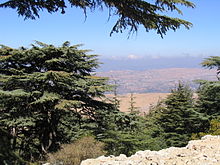
Back أرز (شجرة) Arabic ارز (نبات) ARZ Cedrus AST Sidr Azerbaijani سیدر AZB Кедр Byelorussian Кедр BE-X-OLD Кедър Bulgarian ཐང་ཁྲག Tibetan Cedrus Catalan
| Cedar | |
|---|---|

| |
| Lebanon cedar in Al Shouf Cedar Nature Reserve, Barouk, Lebanon | |
| Scientific classification | |
| Kingdom: | Plantae |
| Clade: | Tracheophytes |
| Division: | Pinophyta |
| Class: | Pinopsida |
| Order: | Pinales |
| Family: | Pinaceae |
| Subfamily: | Abietoideae |
| Genus: | Cedrus Trew |
| Species | |
|
See text | |
Cedar (scientific name Cedrus) is a genus of cone-bearing trees in the plant family Pinaceae. They are native to the Mediterranean region.
Cedars are trees up to 30–40 metres (98–131 ft) (occasionally 60 metres (200 ft)) tall. They have spicy-scented wood, thick ridged or square-cracked bark, and broad, level branches. The shoots are of two kinds, long shoots, which form the framework of the branches, and short shoots, which carry most of the leaves. The leaves are evergreen and needle-like, 8–60 mm long, arranged in an open spiral on long shoots, and in dense spiral clusters of 15–45 together on short shoots; they vary from bright grass-green to dark green to strongly glaucous pale blue-green, depending on the thickness of the white wax layer which protects the leaves from drying out. The female seed cones are barrel-shaped, 6–12 cm long and 3–8 cm broad, green at first, then maturing grey-brown, and, as in Abies, disintegrate when mature to release the winged seeds. The seeds are 10–15 mm long, with a 20–30 mm wing; as in Abies, the seeds have 2–3 blisters, containing an unpleasant-tasting resin, thought to be a defence against squirrels eating them. Cones take one year to mature, with pollination in autumn and the seeds maturing the same time a year later. The male pollen cones are slender, egg-shaped, 3–8 cm long, produced in late summer and shedding pollen in autumn.[1]
- ↑ The maturation and dispersal of cedar cones and seeds. International Dendrology Society Yearbook 1993: 43–46.